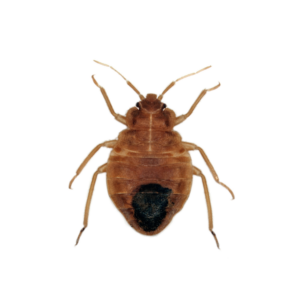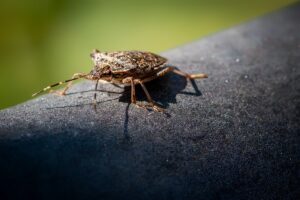Few pests provoke as much frustration and concern as stink bugs and bed bugs. Understanding the differences between these pests is crucial for effective pest management.
By learning about their habits, behaviors, and preferred habitats, homeowners can take proactive measures to prevent infestations and mitigate the impact of these troublesome creatures on their lives. Join us as we learn more about stink bugs vs. bed bugs, providing you with top insights into their biology, behavior, and strategies for keeping them at bay.
Bed Bug Basics
These tiny, reddish-brown insects belong to the Cimicidae family, a blood-sucking insect group that targets humans and animals. Despite their name, bed bugs aren’t limited in their range– they can infest sofas, chairs, clothing, and even public transportation seats.
Bed bugs can travel by latching onto luggage, clothing, and furniture, traveling from one location to another to find their next blood meal. Because these pests exclusively feed on blood, humans are their preferred hosts, and they’ll go to great lengths to track down their next meal.

Ever heard the saying, “Sleep tight; don’t let the bed bugs bite?” It has some truth to it! These pests often attack when your body has settled down during sleep, only emerging when you’re immobile. Because you usually feel no pain from the initial bite, many homeowners don’t realize they’re infested until welts appear days later.
Their bites aren’t known to transmit disease, but they can still cause discomfort, itching, and allergic reactions in some individuals. You may even mistake these injuries for mosquito or flea bites!
Eradicating a bed bug is easier said than done. Because of their slight stature, these pests can slip into unseen cracks and crevices during the day to avoid detection. Plus, these pests are fast reproducers— females can lay hundreds of eggs in their short lifetime.
Without fast action from a pest control professional, a simple infestation can quickly turn into a major problem. At the first sign of bed bugs, be sure to give proof. a call.
The Pungent World of Stink Bugs
Now, let’s focus on another common household pest: stink bugs. These shield-shaped insects belong to the Pentatomidae family and are known for their distinctive odor when crushed or disturbed. While native to Asia, several species of stink bugs have become invasive pests in North America, including the brown marmorated stink bug (Halyomorpha halys).

Stink bugs are primarily plant feeders, using their piercing-sucking mouthparts to extract sap from crops and ornamental plants. They are attracted to warm, sunny areas and enter homes in large numbers during the fall months to seek shelter from the cooler temperatures.
A stink bug’s most notorious characteristic is its defensive mechanism, a pungent, foul-smelling odor that it releases when threatened or crushed. This odor helps stink bugs avoid predation and survive in their natural environment.
Unlike bed bugs, stink bugs do not feed on blood and are not known to transmit diseases to humans. However, their feeding habits can cause damage to a wide range of crops, including fruits, vegetables, and ornamental plants. In agricultural settings, stink bugs can reduce crop yields and quality, leading to financial losses for farmers and gardeners.
Like bed bugs, stink bugs have a relatively simple life cycle consisting of egg, nymph, and adult stages. Female stink bugs lay clusters of eggs on the undersides of leaves, which hatch into nymphs that resemble smaller versions of the adults. Nymphs undergo several molts before adulthood, feeding voraciously on plant sap and growing into mature stink bugs.
Stink Bugs vs. Bed Bugs: Spotting the Differences
While stink bugs and bed bugs are common household pests, they vastly differ in their behavior, appearance, and impact on human life. Let’s delve into the details and explore the key differences between these two troublesome insects.
Appearance
Some of the most apparent differences between stink bugs and bed bugs lie in their appearance. Stink bugs are shield-shaped insects with distinctive markings and coloration, ranging from brown to green to mottled patterns.
Bed bugs are typically reddish-brown in color with oval-shaped, flat bodies. They lack prominent markings and can grow dark and longer after a successful feeding.
Feeding Habits
Stink bugs are plant feeders, using their piercing-sucking mouthparts to extract sap from various crops and ornamental plants. They do not feed on blood and are not known to bite humans or pets.
On the other hand, bed bugs are obligate blood feeders, relying exclusively on blood meals for survival and reproduction. They feed primarily on humans but may bite pets and other warm-blooded animals.
Habitat and Behavior
Stink bugs and bed bugs differ significantly in habitat preferences and behavior. Stink bugs are primarily outdoor pests, preferring warm, sunny areas where they can feed on plant sap and reproduce. They may enter homes searching for shelter during the fall months but do not establish permanent infestations indoors.
Bed bugs, instead, are indoor pests that prefer to dwell in human habitation, particularly in areas where people sleep or rest. They hide in cracks, crevices, and furniture during the day and emerge to feed on their human hosts at night.
Eliminating Stink Bugs vs. Bed Bugs: Tailored Strategies
When dealing with any pest infestation, you’ll need to rely on tailored strategies that address the pest’s unique characteristics and behaviors— stink bugs and bed bugs are no different.
Stink Bug Elimination
Eliminating stink bugs often involves a combination of preventative measures and direct intervention strategies. Since stink bugs primarily feed on plants and do not directly threaten human health, shift your focus to indoor elimination and exclusion strategies.
- Exclusion Techniques: Sealing cracks, gaps, and openings in your home’s exterior can help prevent stink bugs from entering indoor spaces. Installing screens on windows, doors, and vents can also prevent stink bugs while allowing for proper ventilation.
- Habitat Modification: Removing vegetation, clutter, and debris around the home can make the environment less attractive to stink bugs and discourage them from congregating near the structure. Trimming trees and shrubs away from the house can also limit access points for stink bugs and other pests.
- Physical Removal: Vacuuming up stink bugs found indoors and disposing of them in sealed bags can help reduce their numbers.
Bed Bug Elimination
Bed bugs require an intensive and targeted approach, especially considering their swift infestation rates. Never attempt to handle bed bugs independently; rely on trusted pest control professionals to remove a tough infestation for good.
- Professional Treatment: Professional pest control services often employ a combination of chemical treatments, heat treatments, and physical removal techniques to eliminate bed bug infestations. These treatments are tailored to the specific needs of each infestation and may require multiple applications for complete eradication.
- Steam Treatment: Steam treatment is another effective method for killing bed bugs and their eggs on contact. High-temperature steam is applied to infested areas, penetrating cracks and crevices where bed bugs hide and reproduce. This method is safe for most surfaces and can help supplement other treatment strategies.
- Mattress Encasements: Encasing mattresses, box springs, and pillows in specially designed bed bug-proof encasements can help prevent bed bugs from accessing these hiding spots and infesting bedding materials. Encasements should be left in place for at least a year to ensure any remaining bed bugs are trapped and unable to feed or reproduce.
Eliminate Pests with proof.!
At proof. Pest Control, we understand the unique challenges posed by stink bugs and bed bugs, and we’re committed to providing you with tailored solutions that meet your needs. Our comprehensive pest management services can combat infestations using cutting-edge techniques and treatments.
Our Pest-free Guarantee service even covers 30 common household pests, including stink bugs and bed bugs! When protecting your home and family from pests, trust the experts at proof. Pest Control to get the job done right. Contact us today!

